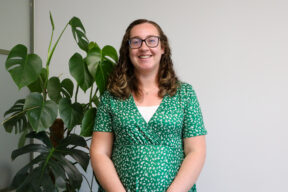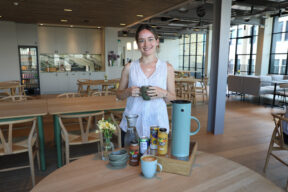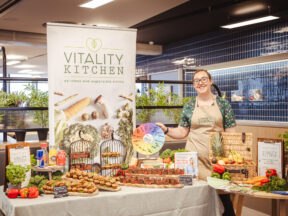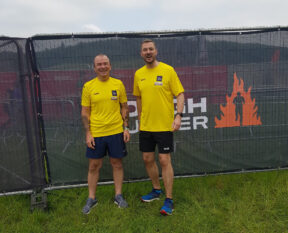Blogs
Jess’s Nicaraguan coffee adventure
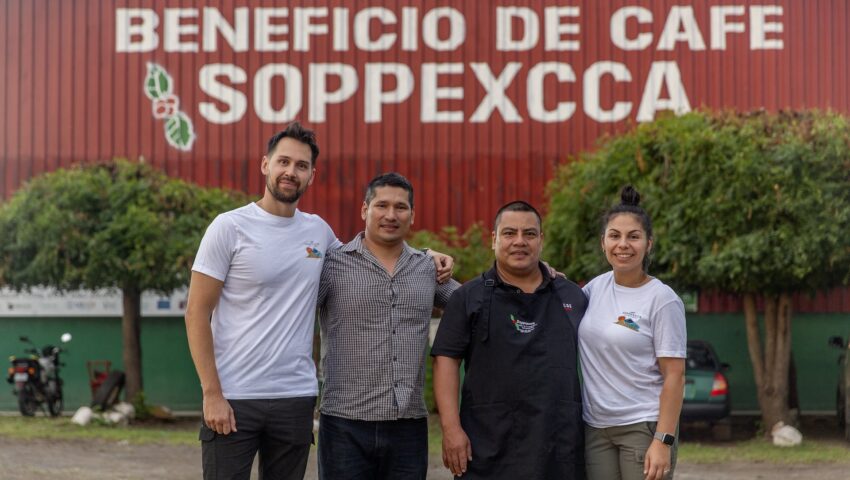
At the heart of every cup of Perkee coffee lies the passion and dedication of our friends and partners at the Soppexcca cooperative in Nicaragua.
Since the end of 2015, we have proudly sourced our fairtrade coffee beans from the Soppexcca cooperative based in Jinotega, Nicaragua. We have forged a partnership built on shared values of quality, sustainability, and community empowerment. Our founder Wendy Bartlett and Lin Dickens, Marketing Director, first visited Nicaragua in 2018, and since then, we visited again in early 2020, and I was lucky to visit again with my colleagues Adrian and Fabio in Autumn 2023. Each visit has deepened our appreciation for the skill and commitment of the Perkee coffee farmers, inspiring us to share their amazing coffee story with our customers. Join me in my diary of our latest visit to Soppexcca, where we met the cooperative’s farmers and celebrate the incredible journey from cherry to cup.
DAY 1: The journey begins
Our journey into the heart of Nicaraguan coffee country commenced with Jesus Fidel picking us up from our hotel in the capital, Managua. The scenic two-hour drive to Beneficio Seco in Matalgapa was a feast for the senses, offering glimpses into the vibrant life of Nicaraguan towns. From bustling streets and kerbside food sellers to lively markets, the energy was infectious. It’s clear that in Nicaragua, the rhythm of life beats to a different tune—one filled with warmth, community, and a deep connection to the land.
Arriving at Soppexcca’s Beneficio Seco (coffee processing plant and mill), we were greeted by Marvin Raul, Quality Manager and Roaster extraordinaire. His passion for coffee was evident from the start, as he welcomed us with a steaming cup of Soppexcca filter coffee. As we sipped our brew, Marvin, along with Wilmor and Santiago, guided us through the intricate process of coffee bean processing.
The coffee beans were categorised into different bodegas (their locality and terrain) and stored with their ‘pergamino’ documentation. It is very important for the coffee to be kept with its pergamino, for traceability. For full traceability, every farmer has access to an app where they can detail their coffees from when they bring it to the dry mill and every process it goes through in the mill.
The beans rest in the mill for at least 40 to 45 days to achieve the best quality. Once the coffee has rested and it’s ready to go, it goes through the dry mill. Here the skin gets removed by the machinery, then goes to a different machine that separates the beans by size, and then it gets scanned by an ultra-expensive high-quality machine. This modern machine has the ability to scan every single bean – about two 70kg bags a minute, and has been designed to select the amount of ‘defect’ beans allowed in the coffee sacks. The amount of defect allowed in each sack is 12% of the beans According to the Green Grading specifications of the Speciality Coffee Association, up to 12 defects are permitted for every 350 grams of coffee; the machine can be set at 0% 0 defects if necessary. They also have another room, where they used to do the sorting by hand, that the scanner machine now does.
When my colleague Lin Dickens first visited Soppexcca in 2019 all the beans were hand sifted! After the tour to understand the coffee process in Beneficio Seco, Marvin gave us four beans to taste and showed us how to do cupping. Cupping is where professionals score the coffee for aspects such as cleanliness, sweetness, acidity, mouthfeel and aftertaste. We tasted five cups of coffee of the same beans, to check their consistency. We tried 4 different types of beans, so in total we cupped 20 coffees. Out of the four coffees, coffee number 2 seemed very different, even for my inexperienced palette. It had a very rich flavour. It turned out this coffee was from Flora’s farm, (who we met later). It was an organic coffee, which had been processed naturally. There was a clear favourite by all the cuppers, besides Soppexcca’s Perkee which was Flora’s. From the meticulous sorting of beans to the careful storage in colour-coded bags, every step was a testament to the dedication and expertise of the Soppexcca cooperative.
DAY 2: A taste of success at La Panaderia
Our second day brought us to La Panaderia, a bakery supported by BM, where the aroma of freshly baked biscuits filled the air. They wanted to show us the progress they made with the bakery which we helped them set up back in 2020.
They now have a professional oven and blender, but they are not substantial enough for the volumes they need to produce to meet demand. They are investigating investing in equipment so they can increase their capacity. They are also making other small progress, like packaging and labels. Here, we witnessed the transformative power of entrepreneurship as women turned dreams into reality. From humble beginnings of baking sesame and honey biscuits at home to a thriving bakery, their journey was inspiring.
They have diversified to baking many types of different sweet and savoury breads, pizza, biscuits and polvorones (almond cookies). As we shared stories and savoured homemade delicacies, it became clear that La Panaderia was more than just a bakery—it was a symbol of hope, resilience, and the enduring spirit of the Jinotegan women. We showed them our video (filmed by my colleague Michaela) of how Perkee coffee is making people happy this side of the Atlantic Ocean. They were very happy to see Perkee coffee being enjoyed by our customers.
DAY 3: Into the heart of coffee country
Venturing deeper into the heart of coffee country, we embarked on a journey to Flora’s organic farm—a hidden gem nestled amidst towering mountains. The lush greenery and crisp mountain air provided a picturesque backdrop as Flora shared her passion for organic farming. From the delicate process of cherry picking to the art of natural processing, every moment was a lesson in sustainability and stewardship of the land.
Later we met Haris who runs the cacao business that’s part of Soppexcca. He explained the whole process from receiving raw cacao to creating beautifully packaged dark chocolate bars ready to sell in their café. He is responsible for the whole process, which is very similar to the coffee process, it needs to have the pulp removed and then dried so the nibs have more flavour. This was the first time I had tried cacao, I tried three different types of cacao. One of them without a doubt was the winner, it tasted very sweet. It looks very different to what we are used to seeing, it has a grainy texture. Growing and selling Cacao to make cacao bars is another way that Soppexcca diversifies their income.
DAY 4: Embracing farm life at El Escambray
Our fourth day immersed us in the daily rhythms of farm life at El Escambray, where we navigated muddy trails and towering banana trees. Despite the rain and mist, the warmth of community and the laughter of children filled the air.
From planting seeds to harvesting crops, we experienced first-hand the dedication and resilience of the Perkee coffee farmers. As we shared meals and stories with the local community, it became clear that our journey was about more than just coffee—it was about forging connections, embracing new experiences, and learning about a determination to do the right thing and triumph over a lot of adversity.
In the downpours we learnt how useful giant banana leaves are for sheltering from the rain! And more importantly the farm is full of banana trees, they provide shelter for the coffee bushes to protect them from the blistering heat of the sun and they add potassium to the soil which is vital for plant growth.
We met Janet, from the women’s coffee association. She helps run a market three times a week. Janet makes baked goods and sells them at the market. Other women also have received help from Soppexcca to set up small market gardens on their farms and sell the produce at the market. They grow produce in different seasons to harvesting coffee so they can receive an income during the whole year. They started at 8:30 am and had run out by 10.30 so it was a good day on the market!
DAY 5: Empowering communities, one cup at a time
As our journey neared its end, we visited the Ernesto Acuña cooperative—a shining example of community empowerment and collaboration. It’s a smaller cooperative that is part of the Soppexcca cooperative. The Ernesto Acuña cooperative farm was called Los Laureles which translates as the Bay Leaves farm.
We walked around the farm with members of the cooperative and they showed how to handpick coffee. They gave us picking baskets which we attached around our waist. The coffee picking was a great highlight for me and Adrian. We turned into a competition to see who could pick the most. I am delighted to say I was the champion!! We were able to experience what the pickers do on a daily basis and how much effort and time goes into the task. It’s not easy at all. Days are long and you are outside.
DAY 6: Reflections and gratitude
As we said goodbye to Nicaragua, I couldn’t help but reflect on the journey that had brought us here. From the bustling streets of Managua to the misty mountains of El Escambray, every moment had been filled with wonder and awe.
But more than the breathtaking scenery or the delicious coffee, it was the people we met along the way who left the biggest impression. Their warmth, resilience, and unwavering spirit reminded me of the power of community and the beauty of human connection. As I sit here, drinking my last cup of Perkee coffee before we depart, I am filled with gratitude for the experiences we shared and the memories we created. Nicaragua Nicaraguita will always hold a special place in my heart—a reminder of the transformative power of travel and the joy of embracing new adventures.
A journey to remember
Our journey to Nicaragua may have come to an end, but the memories we created and the lessons we learned will stay with us forever. From the bustling streets of Managua to the misty mountains of El Escambray, every moment was a testament to the beauty and resilience of the human spirit. As we return home, we carry with us not only bags of Perkee coffee but also a newfound appreciation for the craftsmanship and dedication that goes into every cup. From financial support for women’s entrepreneurship to innovative farming practices, Soppexcca’s commitment to sustainability and social responsibility was evident at every turn. Thank you, Nicaragua, for an adventure of a lifetime.


